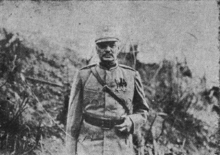| Romanian military intervention in Bessarabia | |||||||||
|---|---|---|---|---|---|---|---|---|---|
| Part of the Allied intervention in the Russian Civil War | |||||||||
 Romanian General Ernest Broșteanu in Bessarabia during 1918 | |||||||||
| |||||||||
| Belligerents | |||||||||
|
|
| ||||||||
| Strength | |||||||||
|
2 cavalry brigades 2 infantry brigades | Unknown | ||||||||
| Casualties and losses | |||||||||
| Unknown casualties |
Unknown casualties 2 floating batteries captured | ||||||||
The Romanian military intervention in Bessarabia took place between 23 January and 20 February 1918, as part of the broader Allied intervention in the Russian Civil War. The Romanian Army, supported by local armed groups, emerged victorious and the former Russian imperial region of Bessarabia – having declared its independence as the Moldavian Democratic Republic – united with Romania later that year.
Background
On 15 December 1917, Moldavia proclaimed itself a constituent republic of the Russian Federative Democratic Republic. On 14 January 1918, the Front Section of the Rumcherod Bolsheviks entered Chișinău, the capital of the nascent republic. After the nationalist faction of the Sfatul Țării requested military assistance from Romania, the Romanian Army crossed the republic's border on 23 January.[1]
Operations
The Romanian forces which carried out the offensive into Bessarabia amounted to two cavalry and two infantry brigades. On 26 January, the Romanian Army captured Chișinău, driving the Bolsheviks out of the city. With the help of Moldavia's improvised combat units, the Romanians pacified Hotin, Ismail, Tighina and Cetatea Albă. The last detachments of Communist revolutionaries were driven over the Dniester and out of the country on 20 February.[2]
Before 6 February the Romanian Army was operating in what was nominally Russian territory. It was only on 6 February that the Moldavian Democratic Republic proclaimed its independence.[3] The Bolsheviks captured Odessa on 29 – 30 January,[4] resulting in Rumcherod being succeeded by the Odessa Soviet Republic on 31 January.[5]
Two ex-Russian floating batteries, K-2 and K-7, were captured by the Romanians in the Danube estuary during February. These vessels, part of the numerous Russud class, each displaced 255 long tons (259 t) and measured 54.7 metres (179 ft 6 in) in length, with a beam of 7.1 metres (23 ft 4 in) and with a draught of 1.2 metres (3 ft 11 in). They had a top speed of 5.5 knots (10.2 km/h; 6.3 mph) generated by two-shaft diesel engines and were each armed with two 152-millimetre (6 in) guns.[6]
Aftermath
The 3rd Red Army launched a counteroffensive on February 20. After some initial successes, the Red forces were forced to withdraw, as the Austro-German Army had started Operation Faustschlag in which they occupied the entire territory of Ukraine.
On 9 April, the Moldavian Democratic Republic united with Romania.[7]
References
- ^ Marcel Mitrasca, Algora Publishing, 2007, Moldova: A Romanian Province Under Russian Rule : Diplomatic History from the Archives of the Great Powers, pp. 34–36
- ^ Andrei Brezianu, Vlad Spânu, Scarecrow Press, 2010, The A to Z of Moldova, p. 38
- ^ Marcel Mitrasca, Algora Publishing, 2007, Moldova: A Romanian Province Under Russian Rule : Diplomatic History from the Archives of the Great Powers, p. 37
- ^ Jonathan D. Smele, Rowman & Littlefield, 2015, Historical Dictionary of the Russian Civil Wars, 1916–1926, p. XXV
- ^ Jonathan Smele, Oxford University Press, 2016, The 'Russian' Civil Wars, 1916–1926: Ten Years That Shook the World, p. 283
- ^ Siegfried Breyer, Conway Maritime Press, 1992, Soviet Warship Development: 1917–1937, pp. 97–98
- ^ Marcel Mitrasca, Algora Publishing, 2007, Moldova: A Romanian Province Under Russian Rule : Diplomatic History from the Archives of the Great Powers, p. 38